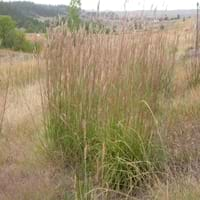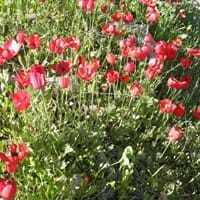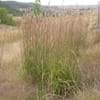Life Span
Perennial
Perennial
Type
Grass
Bulb or Corm or Tuber
Origin
North America, United States, Northeastern United States, Mid-Atlantic United States, Southeastern United States, North-Central United States, Central United States, South-Central United States, Southwestern United States, Texas, Canada, Mexico
Southern Europe, Mediterranean
Types
Not Available
Not Available
Number of Varieties
Not Available
Habitat
meadows, Prairies, Riverbanks, Roadsides, Woods
damp meadows, Dry areas, Woodland edges
USDA Hardiness Zone
2-7
8-12
Sunset Zone
1a, 1b, 2a, 2b, 3a, 3b, 4, 5, 6, 7, 8, 9, 14, 15, 16, 17, 18, 19, 20, 21, 22, 23, 24
21,22
Habit
Clump-Forming
Upright/Erect
Flower Color
Purple
White, Red, Blue, Pink
Flower Color Modifier
Bicolor
Bicolor
Fruit Color
Not Available
Not Available
Leaf Color in Spring
Green
Green
Leaf Color in Summer
Light Green
Light Green
Leaf Color in Fall
Blue Green, Burgundy, Bronze
Several shades of Green
Leaf Color in Winter
Tan, Sandy Brown
Light Green
Leaf Shape
Grass like
Lobed
Plant Season
Summer, Fall, Winter
Spring, Winter
Sunlight
Full Sun, Partial Sun
Full Sun, Partial Sun, Partial shade
Type of Soil
Loam, Sand
Loam, Sand
The pH of Soil
Neutral, Alkaline
Acidic, Neutral, Alkaline
Soil Drainage
Well drained
Well drained
Bloom Time
Late Summer, Early Fall, Fall
Early Spring, Spring, Late Winter, Indeterminate
Tolerances
Not Available
Drought
Where to Plant?
Container, Ground, Pot
Ground, Pot
How to Plant?
Seedlings
Seedlings, Tuber propagation
Plant Maintenance
Medium
Medium
Watering Requirements
Average Water Needs, Do Not over Water, Medium
Medium
In Summer
Lots of watering
Lots of watering
In Spring
Moderate
Moderate
In Winter
Average Water
Average Water
Soil pH
Neutral, Alkaline
Acidic, Neutral, Alkaline
Soil Type
Loam, Sand
Loam, Sand
Soil Drainage Capacity
Well drained
Well drained
Sun Exposure
Full Sun, Partial Sun
Full Sun, Partial Sun, Partial shade
Pruning
Remove damaged leaves, Remove dead branches, Remove dead leaves, Remove dead or diseased plant parts
Remove damaged leaves, Remove dead branches, Remove dead leaves
Fertilizers
All-Purpose Liquid Fertilizer
All-Purpose Liquid Fertilizer
Pests and Diseases
Red blotch
Cutworms
Plant Tolerance
Not Found
Drought
Flower Petal Number
Single
Single, Double, Semi-Double
Foliage Texture
Medium
Fine
Foliage Sheen
Matte
Matte
Attracts
Birds, Butterflies
Butterflies, Hummingbirds, pollinators
Allergy
Not Available
Not Available
Aesthetic Uses
Ground Cover, Landscape Designing, Showy Purposes
Borders, Cottage Garden
Beauty Benefits
Not Available
Not Available
Edible Uses
Insignificant
No
Environmental Uses
Air purification, Food for animals, Prevent Soil Erosion
Air purification
Medicinal Uses
Not Available
Antitumor, Cramps
Part of Plant Used
Leaves, Stem
Flowers, Leaves
Other Uses
Decoration Purposes, Food for animals
Unknown
Used As Indoor Plant
Insignificant
No
Used As Outdoor Plant
Yes
Yes
Garden Design
Cutflower, Dried Flower/Everlasting, Mixed Border, Screening / Wind Break, Wildflower
Bedding Plant, Container, Cutflower, Mixed Border, Rock Garden / Wall
Botanical Name
ANDROPOGON gerardii
ANEMONE coronaria
Common Name
Big Bluestem, Turkey Foot
Crown Windflower, Lilies-of-the-Field, Poppy-flowered Anemone, wind flower
In Hindi
Big Bluestem grass
Poppy Flowered Anemone
In German
Große Bartgras
Kronen-Anemone
In French
Barbon de Gérard herbe
Anémone couronnée
In Spanish
hierba andropogon grande
Poppy flowered Anemone
In Greek
Big BLUESTEM γρασίδι
Poppy Flowered Anemone
In Portuguese
Vetiver grande grama
Poppy Flowered Anemone
In Polish
Big Bluestem trawa
Zawilec wieńcowy
In Latin
Big bluestem herba
Poppy Flowered Anemone
Phylum
Magnoliophyta
Anthophyta
Class
Lillosida
Equisetopsida
Order
Poaceae
Ranunculales
Family
Poaceae
Ranunculaceae
Clade
Angiosperms, Commelinids, Monocots
Angiosperms, Eudicots
Tribe
Not Available
Not Available
Subfamily
Not Available
Not Available
Number of Species
Not Available
Season and Care of Big Bluestem and Poppy Flowered Anemone
Season and care of Big Bluestem and Poppy Flowered Anemone is important to know. While considering everything about Big Bluestem and Poppy Flowered Anemone Care, growing season is an essential factor. Big Bluestem season is Summer, Fall and Winter and Poppy Flowered Anemone season is Summer, Fall and Winter. The type of soil for Big Bluestem is Loam, Sand and for Poppy Flowered Anemone is Loam, Sand while the PH of soil for Big Bluestem is Neutral, Alkaline and for Poppy Flowered Anemone is Acidic, Neutral, Alkaline.
Big Bluestem and Poppy Flowered Anemone Physical Information
Big Bluestem and Poppy Flowered Anemone physical information is very important for comparison. Big Bluestem height is 38.10 cm and width 152.40 cm whereas Poppy Flowered Anemone height is 30.50 cm and width 10.20 cm. The color specification of Big Bluestem and Poppy Flowered Anemone are as follows:
Big Bluestem flower color: Purple
Big Bluestem leaf color: Green
Poppy Flowered Anemone flower color: White, Red, Blue and Pink
- Poppy Flowered Anemone leaf color: Green
Care of Big Bluestem and Poppy Flowered Anemone
Care of Big Bluestem and Poppy Flowered Anemone include pruning, fertilizers, watering etc. Big Bluestem pruning is done Remove damaged leaves, Remove dead branches, Remove dead leaves and Remove dead or diseased plant parts and Poppy Flowered Anemone pruning is done Remove damaged leaves, Remove dead branches and Remove dead leaves. In summer Big Bluestem needs Lots of watering and in winter, it needs Average Water. Whereas, in summer Poppy Flowered Anemone needs Lots of watering and in winter, it needs Average Water.





